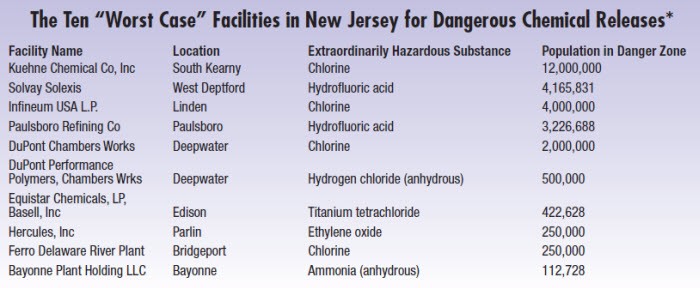One year ago, a train derailed from a bridge, and a cloud of highly toxic, vinyl chloride spread through the town of Paulsboro in Gloucester County. Nearly 700 residents were evacuated and at least 100 were sickened. The full impact of the exposure people suffered may not be known for years, including possible future liver cancers.
We do know that New Jersey has 90 facilities that use large amounts of highly hazardous chemicals that could cause similar—or worse—disasters. They are located in 19 of the 21 counties in the state. A major toxic release from an accident, superstorm, or terrorist attack could put millions of people in danger. The table shows the ten industrial plants that would place the largest number of residents, as well as school students and educators, at potential risk.
Good laws, lax enforcement
The federal government passed the Emergency Planning and Community Right to Know Act (EPCRA) in 1986 following the disastrous chemical release in Bhopal, India, that killed thousands of people. EPCRA requires facilities that manufacture, process, or store designated hazardous chemicals to provide inventories of these chemicals as well as Material Safety Data Sheets (MSDSs) describing the properties and health effects of these chemicals to state and local officials, local fire departments, and to the public.
Local governments, in turn, are required to prepare chemical emergency response plans. Finally, states must establish Local Emergency Planning Committees (LEPCs) to help prevent and respond to chemical incidents. New Jersey established LEPCs in every county and municipality.
However, in the case of Paulsboro, there was a complete failure to meet the intent of EPCRA. First responders were not told of the hazards of vinyl chloride (VC) nor provided with adequate personal protective equipment. Children were sent home from schools, some walking through a VC fog. Evacuation orders were confusing, and disarray among agencies caused inexcusable delays. Neither Paulsboro nor Gloucester County had effective Local Emergency Planning Committees (LEPCs), even though trains carrying toxic chemicals cross the town four to five times a day.
Following 9/11, the focus in New Jersey turned to protection against terrorist attacks, emphasizing securing facility perimeter with gates, guards and other measures. But this response is inadequate. It makes far more sense to prevent the impact of hazardous chemicals on workers and communities by prodding facilities to use safer chemicals and processes, whenever feasible.
In response to a campaign led by the New Jersey Work Environment Council (NJWEC), a frequent NJEA partner, the New Jersey Department of Environmental Protection (DEP) issued rules in 2008 under the state Toxic Catastrophe Prevention Act to require certain facilities to review whether they could switch to safer chemicals or processes. Over the last decade, nearly 300 water and wastewater treatment plants that formerly used highly dangerous chlorine have switched to safer processing methods using UV radiation, ozone or sodium hypochlorite for disinfection. Much to its credit, our state was the first in the nation to take this preventive approach.
While emergency planning is essential, there will be far fewer and less severe emergencies if such prevention strategies are implemented. However, Gov. Christie has turned a blind eye to facilities that are not switching to safer chemicals and processes. Nor has the DEP been provided enough staff to thoroughly review required facility reports.
What locals associations can do
- Local associations can work with their UniServ field representative to assess serious hazards in their area, and take steps toward hazard reduction and emergency preparedness. These might include:
- Meet with the town and/or county LEPC, if there is an active one. If there isn’t, work to ensure an active committee is established.
- Review the local emergency plan to ensure it is effective.
- Join the LEPC and work on improving the emergency plan. There is a checklist in Appendix C of the recent report from NJWEC that you can use to evaluate the plan. (see sidebar).
- If there is a particular facility where you want to press management for safer chemicals or processes or a better emergency response plan, your local association officials can contact NJWEC to try and set up a meeting with the plant union and management.
- Support national efforts to push the Environmental Protection Agency (EPA) to issue regulations and guidance for facilities to implement inherently safe chemicals and technologies. Work with NJWEC and the Coalition to Prevent Chemical Disasters, which includes over 100 organizations calling on President Obama and the EPA to take action to prevent chemical disasters (See Sidebar). This is an opportune time, as President Obama issued an executive order on Aug. 1 requiring three federal agencies to coordinate their activities to propose new policies that will significantly enhance the safety and security of chemical facilities.

This table is excerpted from the report by NJWEC, Failure to Act: New Jersey Jobs and Communities
are Still at Risk from Toxic Chemical Disaster
For More Information
- Much of the material for this article comes from the 2013 report from the NJ Work Environment Council (NJWEC), Failure to Act: New Jersey Jobs and Communities are Still at Risk from Toxic Chemical Disaster: www.njwec.org/PDF/Reports/FailuretoAct_CompleteReport.pdf.
- The Coalition to Prevent Chemical Disasters: preventchemicaldisasters.org.
- For a list of local LEPC addresses: https://sema.dps.mo.gov/docs/programs/executive/MERC/LEPC_Manual/LEPC-addresses.pdf.
- NJ Department of Health Hazardous Substance Factsheets can be found for vinyl chloride and other extremely hazardous chemicals (such as anhydrous ammonia, chlorine and hydrofluoric acid) at https://web.doh.state.nj.us/rtkhsfs/indexfs.aspx.
